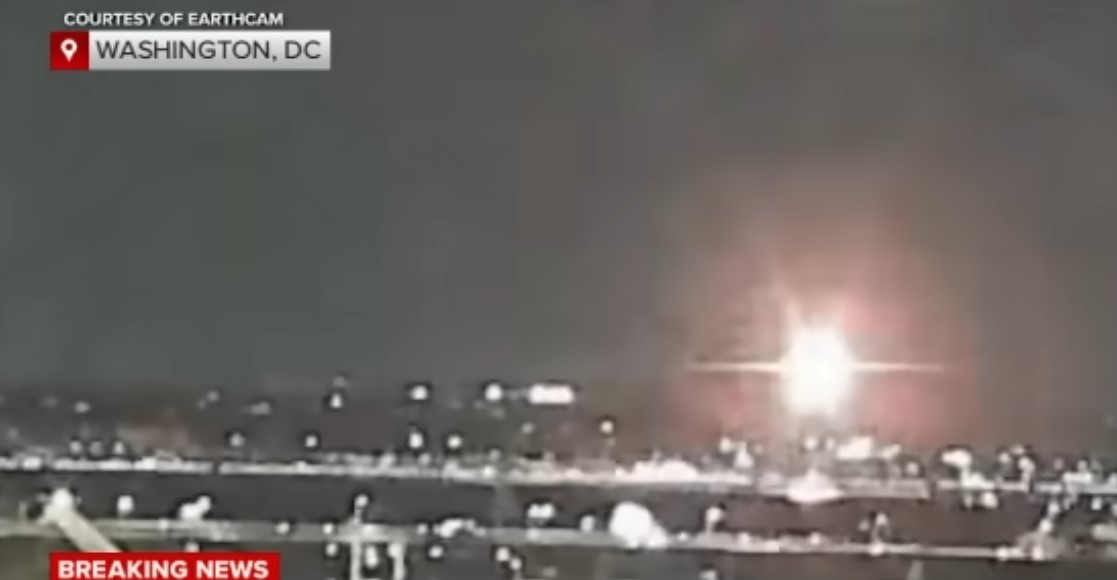
Just a few miles from the heart of Washington, D.C., a devastating tragedy unfolded in the skies above the Potomac River. NEW VIDEO obtained by CNN below.
New VIDEO from CNN Below.
An American Eagle passenger jet collided midair with a U.S. Army Black Hawk helicopter near Ronald Reagan Washington National Airport, claiming the lives of all 67 people aboard the two aircraft. The incident, which marks the first major U.S. commercial airline crash in over a decade, has left the nation grappling with profound grief and difficult questions.
A Collision That Shook the Nation
The collision occurred at approximately 9 p.m. on January 29, as American Eagle Flight 5342, a regional jet carrying 60 passengers and four crew members, was preparing to land at Reagan National Airport. The flight had departed from Wichita, Kansas, earlier that evening. At the same time, a U.S. Army Black Hawk helicopter, part of a routine training mission, was navigating the same airspace.
In an instant, the two aircraft collided, creating a fiery explosion that lit up the night sky. The crash was captured on a livestream camera at the Kennedy Center, a haunting image that has since been shared widely. Both aircraft plummeted into the icy waters of the Potomac River, scattering debris across a wide area. Rescue teams worked tirelessly through the night, but by morning, officials confirmed the heartbreaking reality: there were no survivors.
As of now, 28 bodies have been recovered, and the search continues for the remaining victims. The wreckage lies in shallow water, a grim reminder of the lives lost and the fragility of the systems we rely on.
The Faces Behind the Numbers
This tragedy is not just about numbers; it’s about people—mothers, fathers, children, friends, and colleagues. Among the victims were members of the figure skating community, including U.S. and Russian athletes, coaches, and their families. They were returning from a training camp in Wichita, their dreams and ambitions now tragically cut short.
The figure skating world is mourning the loss of two former Russian world champions, Evgenia Shishkova and Vadim Naumov, who had become beloved coaches in Boston. Their deaths, along with those of their fellow passengers, have sent shockwaves through the global sports community.
For the city of Wichita, where the flight originated, the loss feels deeply personal. Kansas Senator Roger Marshall described the tragedy as “unbearable sorrow,” while Wichita Mayor Lily Wu called it a “terrible tragedy that will forever connect our city to Washington, D.C., in grief.”
Searching for Answers
As investigators from the National Transportation Safety Board (NTSB) and the Federal Aviation Administration (FAA) begin their work, the nation is left asking: How could this happen? Early reports suggest that the helicopter was instructed to pass behind the jet, but something went catastrophically wrong. Was it a miscommunication? A mechanical failure? Human error? These are the questions that must be answered in the days and weeks ahead.
Transportation Secretary Sean Duffy has already called the collision “absolutely preventable,” though he urged patience as the investigation unfolds. The skies over Washington, D.C., are among the most tightly controlled in the world, making this incident all the more shocking. It’s a stark reminder that even in the most secure systems, vulnerabilities can exist.
A Wake-Up Call for Aviation Safety
This tragedy has reignited concerns about the safety of U.S. airspace, particularly in congested areas like Washington, D.C. It also raises questions about the integration of military and civilian aviation operations. How do we ensure that such a disaster never happens again?
For years, the U.S. has enjoyed an unparalleled record of aviation safety. The last major commercial airline crash occurred in 2009, and the industry has since made significant strides in technology and training. But this incident is a sobering reminder that complacency can have devastating consequences. It’s a call to action for regulators, airlines, and policymakers to reevaluate and strengthen the systems that govern our skies.
A Nation in Mourning
In the aftermath of this tragedy, the focus must remain on the victims and their families. American Airlines CEO Robert Isom expressed “deep sorrow” for the crash, pledging the company’s full cooperation with the investigation. President Donald Trump, newly briefed on the incident, called it a “terrible accident” and promised to provide all necessary resources to uncover the truth.
But beyond the immediate grief lies a broader challenge: how to honor the lives lost by ensuring that such a tragedy never happens again. The Reagan Airport collision is not just a story of loss; it’s a story of accountability, resilience, and the collective responsibility we share to protect one another.
As the nation mourns, we are reminded of the fragility of life and the importance of vigilance. The victims of this tragedy were people with dreams, families, and futures. Their loss is a profound reminder of the stakes involved in aviation safety and the need for constant vigilance.
In the days ahead, as the investigation continues and the nation grapples with this loss, let us hold the victims and their families in our hearts. And let us commit to learning from this tragedy, so that the skies above us remain a place of safety and trust.
